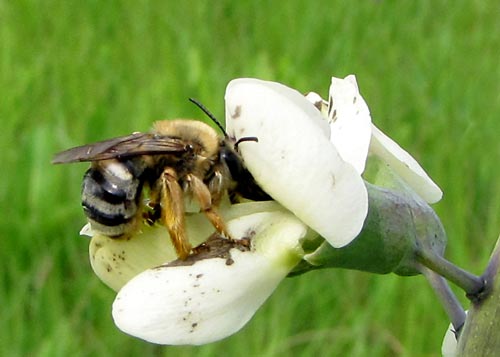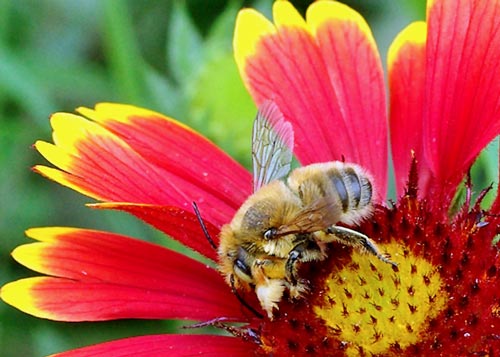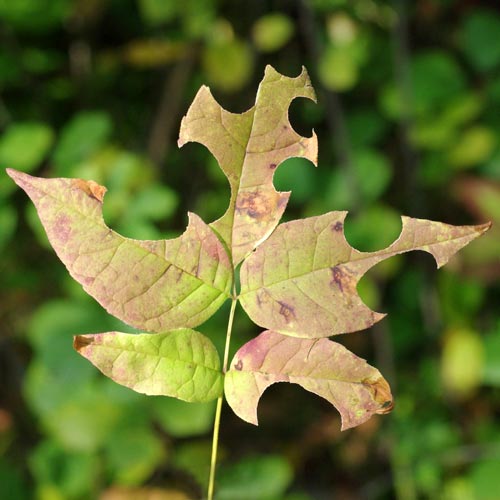Salutations, BugFans,
The word “bee” is widely misused—usually referring to any yellow and black flying object, whether bee, wasp, hornet, or syrphid fly—and it’s probably misapplied most frequently to the German yellowjackets that buzz the picnic table or garbage can.
“True” bees have, somewhere on their body (particularly on the thorax), hairs that are branched or feathery, not simple, and the top of the first segment of their thorax looks kind of like a collar. Bees are pollen-eaters, so most species also have some mechanism for collecting it.
Honey bees and bumble bees are easily recognized, but distinguishing between the different tribes and families of bees can be sticky. In fact, the taxonomy of bees is a lot more complicated than the BugLady thought, and she will try to spare BugFans too many of the gory details. The short version is that Hymenoptera (ants, bees and wasps) is a huge order that is divided up into a lot of sub/super-groups that are stuck in between the usual Order-Family-Genus-Species progression, and, of course, the names of the many sub-divisions are not universally agreed on. Picture a Family Tree diagram/outline with Hymenoptera at the top. Below Hymenoptera are several major taxons (sub-groups), one of which is Aculeata (the bees, ants and stinging wasps). Aculeata is sub-divided into several groups, including one named Apiformes/Anthrophila/Apoidea (a little name squabble, there). Apiformes/etc. is divided into bee families like Apidae and Megachilidae.
Most Hymenopterans are solitary—relatively few species of bees (or of wasps, hornets, or yellowjackets) follow the familiar communal nesting model of a honeybee or an ant society headed by a green or queens that are cared for by a worker caste. Although most bees have a stinger, you generally have to talk the non-social bees into stinging you; the social bees are “touchier” and will sting to protect hearth and home and nursery.
Long-Horned Bees
Long-Horned Bees are in the family Apidae (and the tribe Eucerini, which means well-horned in Greek, and refers to the long antennae sported by the males). LHBs are described as large, fuzzy and robust, with banded posteriors. Many LHBs are plant specialists that pollinate crops around the world (females carry pollen on brushes of hair—scopa—on their hind legs). According to Wikipedia, an LHB called the Squash bee makes possible a half-billion dollar agricultural industry.
LHB nests are vertical tunnels in the ground, in plant stems or in wood; tunnel and cells are lined with a waxy material produced by the bee. A female LHB stocks a cell with pollen and nectar for her larvae (solitary wasps provision chambers with stunned insects and spiders for their more blood-thirsty offspring). She lays an egg on a ball of pollen, one egg per cell.
As near as the BugLady can tell, and she has looked long and hard at the rear ends of many bees in many photos, the bee on the white Baptisia is either in the genus Melissodes (Digger Bee and Anthophora) or the genus Eucera (Digger bee and Eucera hamata). BugFans can take a peek and come to their own conclusions. The basic biology and life histories of the two genera are similar.
Melissodes is a large genus of about 120 species of hairy bees with yellow faces. They are mid-day flyers that are important pollinators, mainly of asters, daisies, and sunflowers (California sunflower growers depend on them). Their nests are parasitized by a cuckoo bee that lays its egg in a cell, and its larva eats the pollen supply stored for the unfortunate LHB.
Eucera (a.k.a. Tetralonia) contains 55 species in the U.S. and a few hundred more worldwide. This could be Eucera hamata, a common Eastern LHB that feeds on a variety of flowers, excluding composites. One of Eucera’s predators is the larva of an oil/blister beetle (Meloe americana). The freshly-hatched beetle larva hitches a ride on an adult LHB it encounters on a flower and travels to the bee’s nest (each Meloe beetle species specializes in a different species of bee). There it feeds on the provisions in a cell, on the bee larva, or both.
Leafcutter Bees
Is the bee on the orange and yellow blanket flower another LHB? That would be way too easy. Leafcutter Bees are also in the Aculeata group and in the Apoidea/Anthophila/Apoidiformes sub-group, but they’re in the bee family Megachilidae. There are about 130 species of leafcutter bees in North America, including an alien leaf-cutter called the Alfalfa Leafcutter that was imported to pollinate the (alien) alfalfa crop, and there are many more species around the world. This bee was ID’d for the BugLady as a member of the genus Megachile (thanks, Amy).
Leafcutter bees are chunky, hairy bees with large heads and strong mandibles. Their long tongues allow them to collect nectar hidden deep down in flowers. This Megachile’s front legs look like a Percheron, but she doesn’t use her legs to collect pollen, she uses a pollen brush on the underside of her abdomen.
Megachile means large lip in Greek and refers to the bee’s mouthparts. Female leafcutter bees use those mouth parts to snip circles/semi-circles out of leaf edges. She uses the cut-outs to line nest tunnels that she makes in stems, in the ground or in a pre-existing cavity. Starting at the far end of a tunnel, she constructs a series of egg chambers, end-to-end, and provisions each with a supply of pollen. Like the LHB, she lays an egg on the food, caps the cell, and moves on to the next. The larvae eat, grow, and pupate without ever leaving the tunnel. Some sources say that males emerge first, but the Audubon Society Field Guide to North American Insects and Spiders says that the adults mature randomly within the tunnel, and then everyone waits until all have emerged from their pupal cases before they exit the tunnel sequentially!
Interested in native bees? Check out “Meet the Bees” on page 11 of The Missouri Prairie Journal, and Bee Basics: An Introduction to Our Native Bees, a USDA Forest Service and Pollinator Partnership Publication.
In her searches for information about these two bees, the BugLady kept getting steered to two citizen science projects that monitor populations of native pollinators. One is called the Great Pollinator Project and the other is a western group, the Great Sunflower Project. Both list as partners/initiators the Center for Biodiversity and Conservation at the American Museum of Natural History. Wild honeybees (feral populations of the imported, domestic bee) have been declining for some time, and the colony collapse disorder affecting today’s domestic hives is well-documented. Some native bees, including a few bumblebee species, are also in danger. Mites, habitat loss, decreasing numbers of bee-keepers, pesticides, and loss of diversity as a result of planting large monocultures (large areas with a single crop) for biofuel production are some of the factors in the decline of pollinators.
The BugLady


